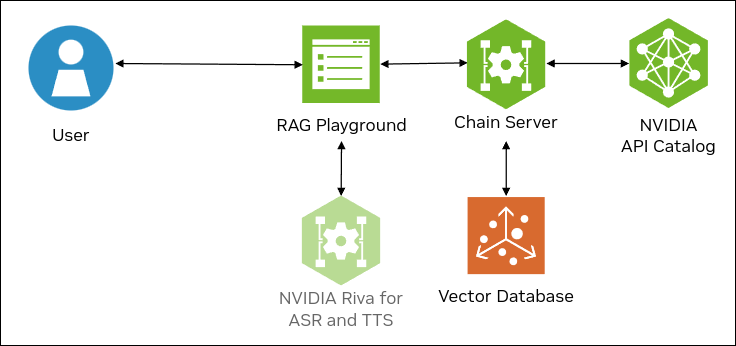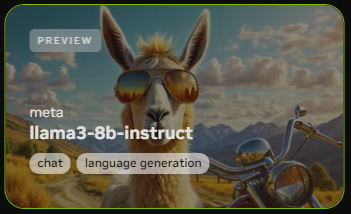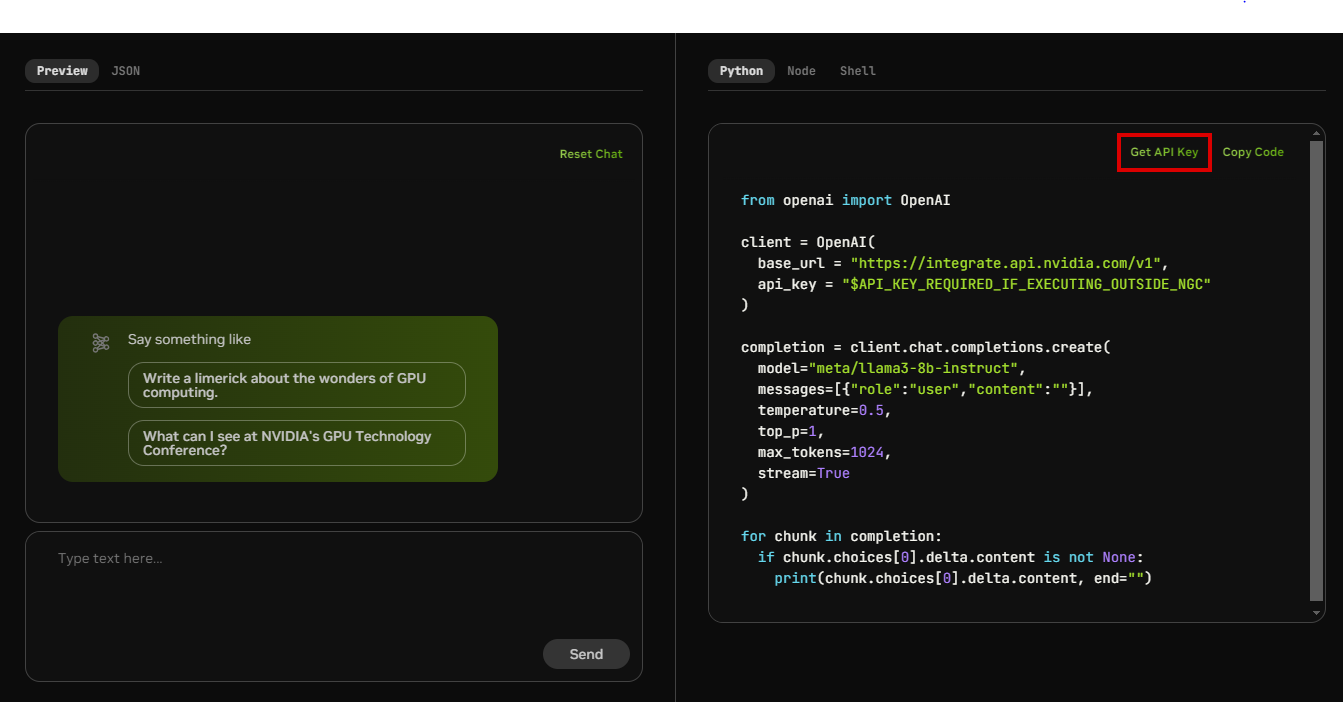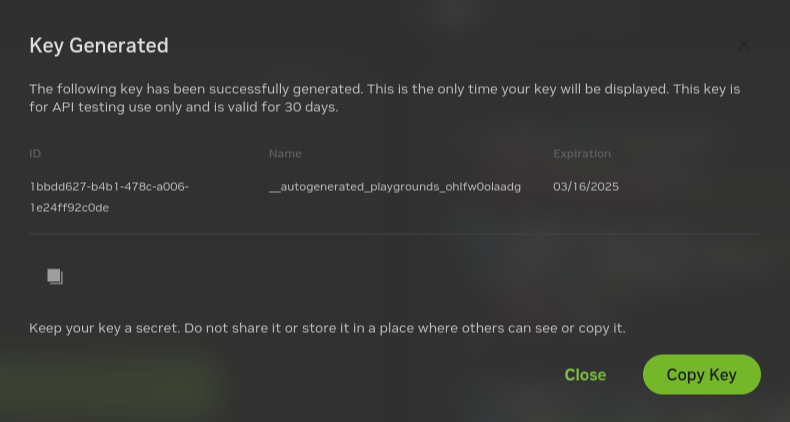Multimodal Data
Example Features
This example deploys a developer RAG pipeline for chat Q&A and serves inferencing from NVIDIA API Catalog endpoints instead of a local inference server, a local LLM, or local GPUs.
Developers get free credits for 10K requests to any of the available models.
The key difference from the Using the NVIDIA API Catalog example is that this example demonstrates how work with multimodal data. The model works with any kind of image in PDF or PPTX, such as graphs and plots, as well as text and tables.
This example uses models from the NVIDIA API Catalog.
Model |
Embedding |
Framework |
Description |
Multi-GPU |
TRT-LLM |
Model Location |
NIM for LLMs |
Vector Database |
|---|---|---|---|---|---|---|---|---|
meta/llama3-8b-instruct for response generation ai-google-Deplot for graph to text conversion ai-Neva-22B for image to text conversion |
snowflake-arctic-embed-l |
Custom Python |
QA chatbot |
NO |
NO |
API Catalog |
NO |
Milvus |
The following figure shows the sample topology:
The sample chat bot web application communicates with the chain server. The chain server sends inference requests to NVIDIA API Catalog endpoints.
Optionally, you can deploy NVIDIA Riva. Riva can use automatic speech recognition to transcribe your questions and use text-to-speech to speak the answers aloud.

Limitations
Although the AI Foundation Models endpoint uses the Neva_22B model for processing images, this example supports uploading images that are part of PDF and PPTX files only. For example, after deploying the services, you cannot upload a PNG, JPEG, TIFF, or any other image format file.
Prerequisites
Clone the Generative AI examples Git repository using Git LFS:
$ sudo apt -y install git-lfs $ git clone git@github.com:NVIDIA/GenerativeAIExamples.git $ cd GenerativeAIExamples/ $ git lfs pull
Install Docker Engine and Docker Compose. Refer to the instructions for Ubuntu.
Login to Nvidia’s docker registry. Please refer to instructions to create account and generate NGC API key. This is needed for pulling in the secure base container used by all the examples.
$ docker login nvcr.io Username: $oauthtoken Password: <ngc-api-key>
Optional: Enable NVIDIA Riva automatic speech recognition (ASR) and text to speech (TTS).
To launch a Riva server locally, refer to the Riva Quick Start Guide.
In the provided
config.shscript, setservice_enabled_asr=trueandservice_enabled_tts=true, and select the desired ASR and TTS languages by adding the appropriate language codes toasr_language_codeandtts_language_code.After the server is running, assign its IP address (or hostname) and port (50051 by default) to
RIVA_API_URIindeploy/compose/compose.env.
Alternatively, you can use a hosted Riva API endpoint. You might need to obtain an API key and/or Function ID for access.
In
deploy/compose/compose.env, make the following assignments as necessary:export RIVA_API_URI="<riva-api-address/hostname>:<port>" export RIVA_API_KEY="<riva-api-key>" export RIVA_FUNCTION_ID="<riva-function-id>"
Get an API Key for the Meta Llama 3 8B Instruct API Endpoint
Perform the following steps if you do not already have an API key. You can use different model API endpoints with the same API key.
Navigate to https://build.nvidia.com/explore/discover.
Find the Llama 3 8B Instruct card and click the card.

Click Get API Key.

Click Generate Key.

Click Copy Key and then save the API key. The key begins with the letters nvapi-.

Build and Start the Containers
In the Generative AI examples repository, edit the
deploy/compose/compose.envfile.Add the API key for the model endpoint:
export NVIDIA_API_KEY="nvapi-..."
From the root of the repository, build the containers:
$ docker compose --env-file deploy/compose/compose.env -f deploy/compose/rag-app-multimodal-chatbot.yaml build
Start the containers:
$ docker compose --env-file deploy/compose/compose.env -f deploy/compose/rag-app-multimodal-chatbot.yaml up -d
Example Output
✔ Network nvidia-rag Created ✔ Container chain-server Started ✔ Container rag-playground Started
Start the Milvus vector database:
$ docker compose \ --env-file deploy/compose/compose.env \ -f deploy/compose/docker-compose-vectordb.yaml \ --profile llm-embedding \ up -d milvus
Example Output
✔ Container milvus-minio Started ✔ Container milvus-etcd Started ✔ Container milvus-standalone Started
Confirm the containers are running:
$ docker ps --format "table {{.ID}}\t{{.Names}}\t{{.Status}}"
Example Output
CONTAINER ID NAMES STATUS 37dcdb4ffcb0 rag-playground Up 3 minutes 39718f6a2a06 chain-server Up 3 minutes 68af1e4dfb44 milvus-standalone Up 2 minutes 522b12ec17f0 milvus-minio Up 2 minutes (healthy) ed48988c5657 milvus-etcd Up 2 minutes (healthy)
Next Steps
Access the web interface for the chat server. Refer to Using the Sample Chat Web Application for information about using the web interface.
Upload one or more PDF and PPTX files with graphics, plots, and tables.
Enable the Use knowledge base checkbox when you submit a question.
Stop the containers by running
docker compose -f deploy/compose/rag-app-multimodal-chatbot.yaml downanddocker compose -f deploy/compose/docker-compose-vectordb.yaml --profile llm-embedding down.